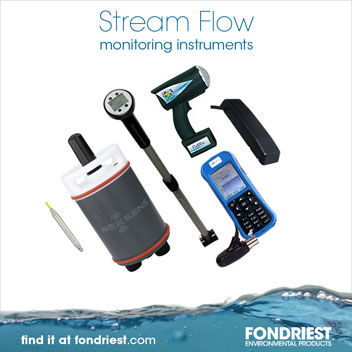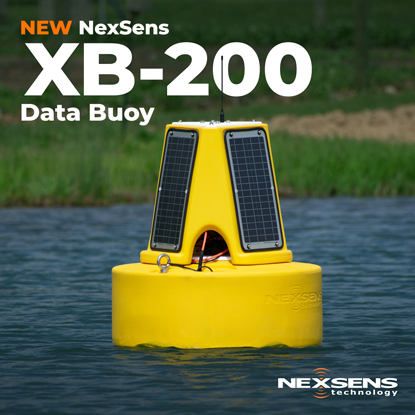Measuring Streamflow
While streams and rivers may be monitored for many qualities and parameters that they share with lakes, ponds and basins, they possess one quality that sets them apart from other freshwater bodies: movement. Streamflow is a keystone parameter that impacts many other aspects of a river’s hydrology and water quality. Although these other aspects may be just as vital to a river’s health — or just as applicable to your particular project — they may be shared with other types of water bodies, and in many cases will be covered in other chapters. For this reason, this chapter will focus primarily on establishing streamflow through stage discharge measurement.
Calculating Streamflow
Streamflow is a measurement of the amount of water flowing through a stream or river over a fixed period of time. Streamflow cannot be measured directly, say, by plunging an instrument into a river. Instead, it must be calculated in a process known as stream gaging. The USGS has been doing this since 1889, when it established its first stream gage on the Rio Grande River in New Mexico to determine how much water was available for irrigation as the nation expanded westward. Today, the USGS operates more than 7,000 stream gages across the U.S., which provides streamflow information used widely for flood prediction, water management, engineering and research, among other uses.
The USGS splits stream gaging into a three-step process: measuring stream stage, measuring discharge and determining the stage-discharge relation.
Measuring Stream Stage
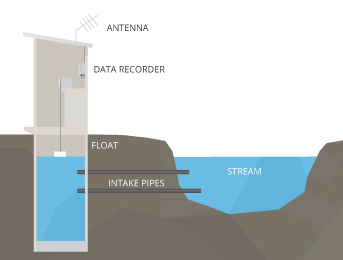 The first step in calculating streamflow involves measuring stage, which is the height of the water surface at a particular point in a stream or river. Stage is sometimes known as gage height, and can be measured several ways. Among the most common of these approaches uses a stilling well installed in the river bank or attached to a stationary structure such as a pier or bridge support. An underwater intake allows water into the stilling well at the same elevation of the river’s surface. A float or a sensor — whether pressure, optical or acoustic — then measures the stage inside the well. An electronic recording device or data logger records stage measurements at regular intervals; in the case of the USGS, usually every 15 minutes. A telemetry system may also be present in a stilling well, allowing data to be transmitted remotely to a host computer in real time.
The first step in calculating streamflow involves measuring stage, which is the height of the water surface at a particular point in a stream or river. Stage is sometimes known as gage height, and can be measured several ways. Among the most common of these approaches uses a stilling well installed in the river bank or attached to a stationary structure such as a pier or bridge support. An underwater intake allows water into the stilling well at the same elevation of the river’s surface. A float or a sensor — whether pressure, optical or acoustic — then measures the stage inside the well. An electronic recording device or data logger records stage measurements at regular intervals; in the case of the USGS, usually every 15 minutes. A telemetry system may also be present in a stilling well, allowing data to be transmitted remotely to a host computer in real time.
It may not always be cost-effective or space-efficient to install a stilling well where stream gaging is necessary. In these cases, stage can be measured with a vented pressure transducer installed within a PVC or metal pipe along the stream bank. In locations where a bridge or overhead structure is available for instrument mounting, a non-contact radar or ultrasonic water level sensor can also be used.
Stage must always be measured relative to a constant reference elevation, or datum. Depending on the duration of your project, it may be necessary to routinely survey the elevation of your stream gage structure and its datum, to ensure that elevations have not shifted due to settling or natural erosion.
Measuring Discharge
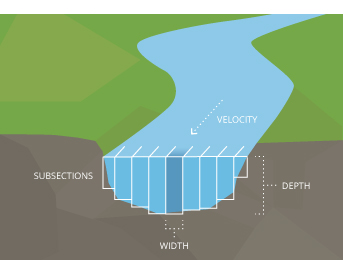 In addition to stage, discharge must also be established before streamflow information can be computed. Discharge is the volume of water moving down a waterway per unit of time. It is most commonly expressed in cubic feet per seconds or gallons per day. To calculate discharge, multiply the area of water in a channel cross section by the average velocity of water in that cross section.
In addition to stage, discharge must also be established before streamflow information can be computed. Discharge is the volume of water moving down a waterway per unit of time. It is most commonly expressed in cubic feet per seconds or gallons per day. To calculate discharge, multiply the area of water in a channel cross section by the average velocity of water in that cross section.
In short: discharge = area X velocity
The simplest way to measure discharge is to divide the channel cross section into vertical rectangular subsections. Once the area (width X depth) of each of these subsections is established and multiplied by velocity to determine subsection discharge, the results can be added together to calculate total discharge.
Subsection width is best measured with a cable or steel measuring tape, while depth can be measured by a wading rod in shallower channels and suspended sounding weights in deeper waters. Velocity, on the other hand, should be measured with a current meter. Many current meters rely on a wheel formed of several cups revolving around an axis. Each revolution generates an electronic signal that is counted and timed by the meter, which translates to water velocity.
A faster, but more expensive method to measure velocity involves the use of an Acoustic Doppler Current Profiler (ADCP) which can be mounted in a small watercraft. The ADCP sends a pulse of sound into the water and measures changes in the pulse’s frequency as it returns to the instrument. The ADCP speeds discharge calculations by measuring velocity and depth at the same time. Width is also measured as the boat-mounted ADCP is navigated across the channel. Though somewhat more limited in capability, rod-mounted Acoustic Doppler Velocimeters allow similar functions to be performed while wading through shallow streams.
Determining the Stage-Discharge Relation
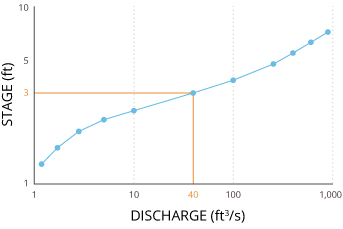 Stage-discharge relation, or “rating,” is a dynamic variable that is determined by comparing stage at a stream gage to discharge at the same point. Accurate stage-discharge relations can only be developed by measuring discharge across many ranges of stage. Furthermore, channels should be continually surveyed for changes caused by erosion, sediment deposition, vegetation growth and ice formation.
Stage-discharge relation, or “rating,” is a dynamic variable that is determined by comparing stage at a stream gage to discharge at the same point. Accurate stage-discharge relations can only be developed by measuring discharge across many ranges of stage. Furthermore, channels should be continually surveyed for changes caused by erosion, sediment deposition, vegetation growth and ice formation.
When discharge has been established across enough stages, stage-discharge relation can be visualized in the form of a graph. When this relation is properly maintained through periodic updates, it can provide useful streamflow information for a given stream or river.
Cite This Work
Fondriest Environmental, Inc. “Streamflow Measurements.” Fundamentals of Environmental Measurements. 17 Sept. 2015. Web. < https://www.fondriest.com/environmental-measurements/measurements/hydrological-measurements/streamflow-measurements/ >.


